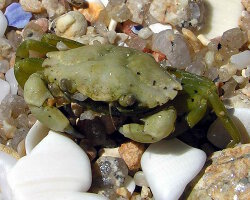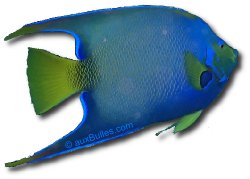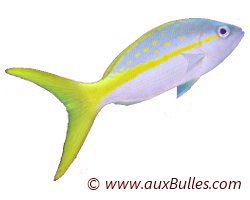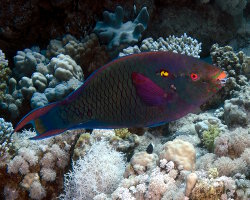Sealife guideThe banded cleaner shrimpStenopus hispidus
Last updated on 07/29/2025 at 10:02 PM

The banded cleaner shrimp (Stenopus hispidus)
Taxonomy
- Common name: Banded cleaner shrimp
- French name: Grande crevette nettoyeuse
- Spanish name: Camarón con bandas de coral
- Scientific name: Stenopus hispidus (Olivier, 1811)
- Family name: Stenopodidae
- Order name: Decapoda
- Class name: The crustaceans [Malacostraca]
Description
The banded cleaner shrimp (Stenopus hispidus) is a small shrimp, barely around four inches in length. It is characterized by its body and large pincers covered with broad red and white bands. It has two pairs of long white antennas.

The banded cleaner shrimp is characterized by its body and large pincers covered with broad red and white bands
Geographic range
The banded cleaner shrimp is mainly found in the Caribbean sea in the reefs of many islands like
Guadeloupe but it is also present in tropical waters of the Indian and Pacific oceans.
Habitat
The banded cleaner shrimp is found from the surface down to about 50 feet deep. It frequents the many crevices found in coral reefs.
Diet
The banded cleaner shrimp primarily feeds on parasites carried by fish but also on small
crustaceans.
Reproduction
The female is larger than the male and it is not uncommon to find a pair tucked inside a crevice with their heads down. The female, whose egg-laying cycle is governed by her molting, carries her eggs for about six weeks until they hatch, giving birth to small larvae that will develop in open water.
Did you know ?
The banded cleaner shrimp spends its day waiting for fish in need of a little cleaning.
Often found in groups with other shrimp or other banded cleaner shrimp, they form actual « cleaning stations » where fish regularly stop by.
Tips for observing
Pay special attention to the reef's crevices while searching for long pairs of white antennas !

The banded cleaner shrimp spends its day waiting for fish in need of a little cleaning
Discover also

Caribbean spiny lobster
(Panulirus argus)

European green shore crab
(Carcinus maenas)

Haig's Porcelain Crab
(Porcellanella haigae)

Peacock mantis shrimp
(Odontodactylus scyllarus)

Pederson cleaner shrimp
(Ancylomenes pedersoni)

Urchin carrier crab
(Dorippe frascone)

Weak shelled rock crab
(Grapsus tenuicrustatus)
The marine species from northwestern Atlantic ocean

Ballyhoo
(Hemiramphus brasiliensis)

Caribbean spiny lobster
(Panulirus argus)

Hogfish
(Lachnolaimus maximus)

Kemp's ridley sea turtle
(Lepidochelys kempii)

Lemon shark
(Negaprion brevirostris)

Longsnout seahorse
(Hippocampus reidi)

Queen angelfish
(Holacanthus ciliaris)

Yellowtail snapper
(Ocyurus chrysurus)





















